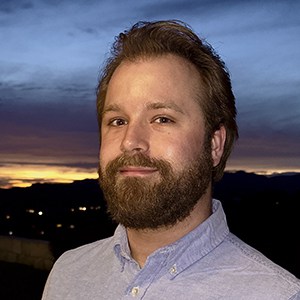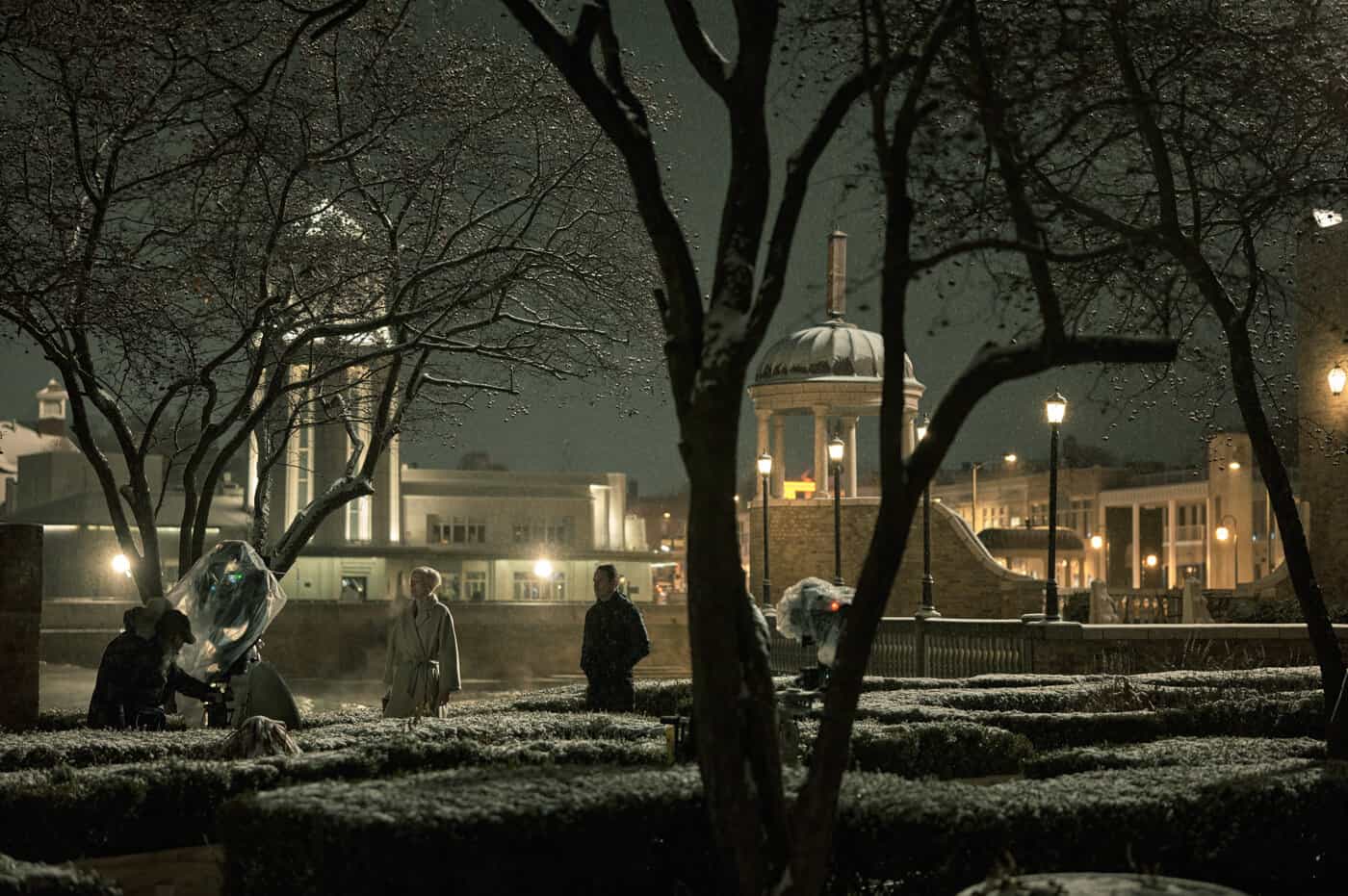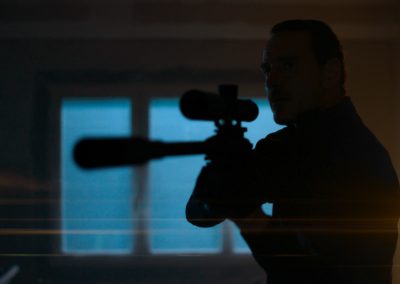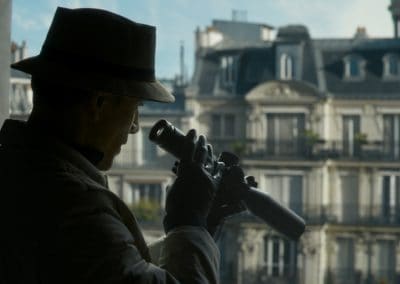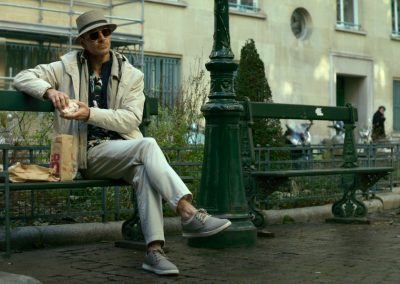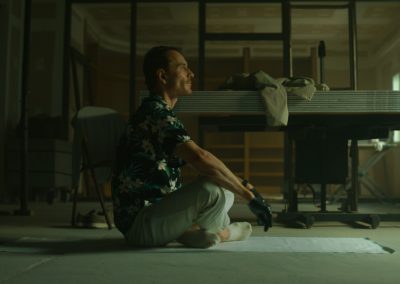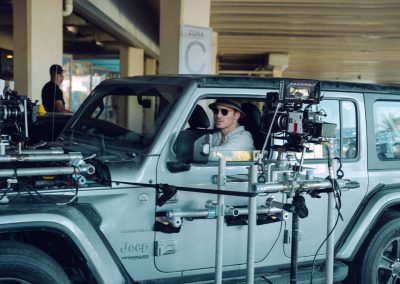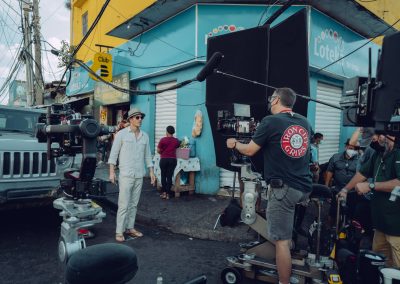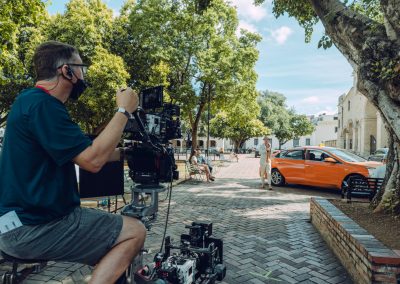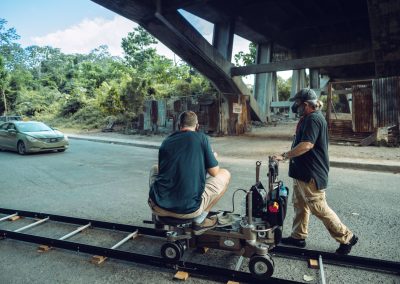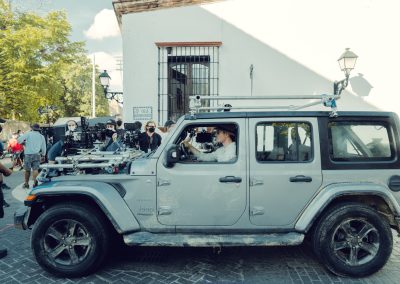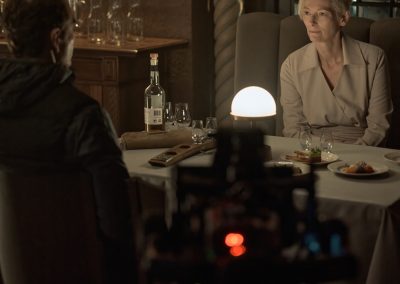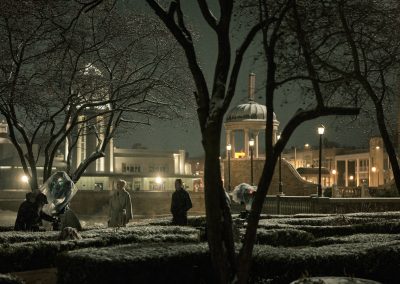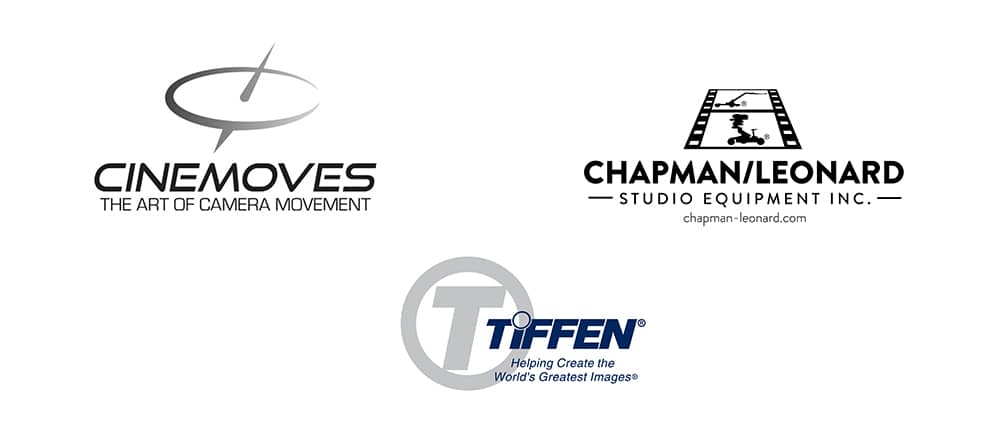The Killer
Silent Killer
A Conversation with Brian Osmond, SOC
By David Daut
Having been in development since 2007, David Fincher’s adaptation of the French comic series The Killer arrives as a slick, stylish, and darkly funny film about a professional assassin desperately trying to project an image of cold, exacting competence, all the while struggling to keep his head above water in the aftermath of a job gone wrong.
With its solo protagonist who goes for long stretches of the film without saying aloud a single word, The Killer often resembles a silent film as much as anything else. Camera Operator had the opportunity to talk with A camera operator Brian Osmond, SOC, about working with Michael Fassbender in this unique role, the camera as “straight man” for the film’s sly comedy, and the professional relationship he’s developed with director David Fincher over the past seven years.
With no name and no background to go on, we meet “The Killer” in Paris, France, in the midst of his preparations to assassinate a similarly unnamed target. After days of meticulous planning, the moment finally comes with the target in sight, ready to take the shot, and he misses! Our mysterious assassin is left trying to pick up the pieces of this botched assassination all the while the situation continues to spiral out of control. The Killer is directed by David Fincher from a screenplay by Andrew Kevin Walker and stars Michael Fassbender, Arliss Howard, Charles Parnell, Kerry O’Malley, Sala Baker, Sophie Charlotte, and Tilda Swinton.
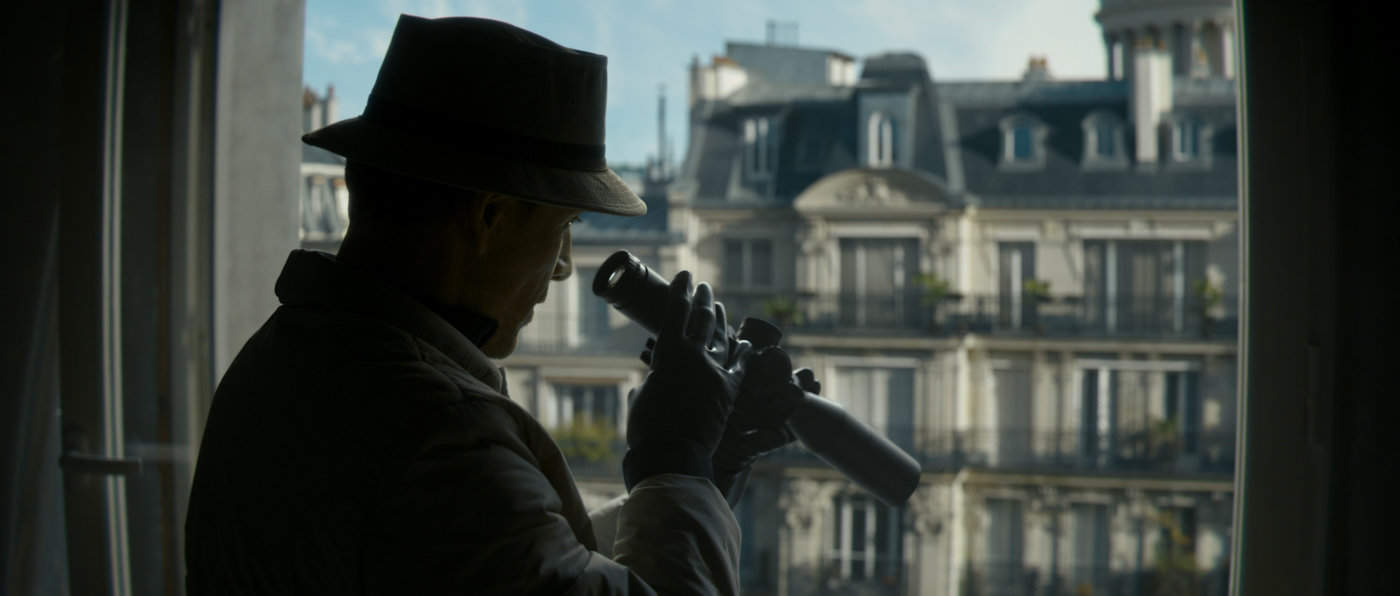
Michael Fassbender as an assasin in THE KILLER
Camera Operator: Let’s talk about the first 20 minutes of the movie. That’s the part that really stuck in my head after the movie. That long, slow burn setup to what’s kind of the movie’s main punch line: him missing the shot after all that meticulous buildup and preparation. Can you talk a little bit about what went into shooting that sequence?
Brian Osmond: Yeah, it is a slow burn, isn’t it? It’s a bit painstaking, but ultimately I really like the sequence. His meticulous nature is obviously on display, and when it finally comes to the moment to pay it all off, he misses! And that sets up the rest of the movie. Shooting it was a lot of work, as you can imagine. The entire sequence, structurally, was made from three pieces: there was the Paris work, there was the stage work with Michael, and there was the stage work for everything across the street, and those are seamlessly combined with compositing and editing.
For the setting of that sequence—the building he’s watching, with the big windows and the beautiful facade with another tall building right across from it—the plan was to find a practical location and just do the work, but that specific architecture doesn’t quite exist in Paris, not like we needed. So, they found a location that had aspects of that and shot from a window with nine different cameras, all rigged up together, capturing action on the street, plates, lighting reference, all of that to be able to build the scene later. The business you see happening down on the street really is Paris, but everything above that in all of the windows was shot later and comped in.
So, part B of that was stage work in New Orleans. We had a set of the room he’s in, that room that’s being renovated, and outside the window was a green screen. Above and below the window, there were LED panels that played the footage back that had been captured in Paris. That gentle movement of the city, particularly at night: cars passing, lights turning on and off, the different times of day, whether it’s sunny or cloudy, those sorts of things were played back on big LED screens so that the light feels authentic. Everything you see outside the window was composited in. The VFX guys did a great job.
And then, part C was what happens across the way. His target finally shows up in the penthouse and he takes the shot, but there’s also the parts where he’s just looking around at the different rooms and the different lives being lived.
CO: Yeah, it’s very Rear Window.
Osmond: Indeed. All of that was done in a warehouse. They built a two- or three-story set of that building with all the windows, each one fully dressed and deep enough to look like a room. I was on a platform about 100 feet back—they had done the math to make sure everything matched the real location in Paris. And that, of course, greatly helps the compositing and the final effect. So much of that sequence was me on a platform, on a tripod, shooting all the way across this warehouse. Most of that work was with a long lens, sometimes objectively where you’re just showing the audience what’s going on, and then sometimes subjectively where the camera becomes the scope or his point of view. That was a lot of fun for me to shoot, particularly the scope work. David gave me some freedom to do what I wanted to do, and I just imagined I was an assassin. What would I look at? I want to take the guy out, but what are other people doing? You want to look around a bit, but you don’t want to lose track of your mark. You’re looking for that moment where you can make the shot. So, I had a lot of fun with that, just imagining I was an assassin for a day. In the end, they put in the scope effect, which looks great.
So, all of those elements—the location work in Paris, the set in New Orleans, and the warehouse—were put together for a great sequence that builds slowly to the moment he takes the shot and misses. Camera-wise, it’s measured work, precise up to that point. Thoughtful compositions, intentional and careful movement, inserts that tell the story, things like that. When he misses, suddenly it’s handheld work where now his world is no longer in control. As our Killer loses control and discipline, the camera does the same.
Now, that handheld work is a bit of a mixture. Sometimes it was traditional handheld, just on my shoulder, using a handheld RED. We shot the whole film with REDs and also committed one camera to an even lighter rig that I could put in front of me. Other times we shot conventionally—track and dollies and things like that—and then in post it was destabilized.
Fincher is maybe more well known for stabilizing footage and making things especially smooth and fluid, but for this we went in the opposite direction. We shot it conventionally, but it was destabilized to make it look handheld. The advantage of destabilization is that it’s a different look. I think it’s its own look, and you have tremendous control over what that can be. We did a little bit of that in Mindhunter. In particular, there was the end of an episode that was ultimately both stabilized and destabilized. That was perhaps an early test for this sort of idea. That particular shot starts off incredibly violent and ends extremely smooth, and it’s all in one shot. It looks like the camera’s out of control, and it ends with what seems like a shot on a dolly. People have asked me about that, what tool I used to do that shot, and it was just done handheld, but with that sort of secret stabilization. Now you have an interesting tool in that you can stabilize and destabilize. That gives you a lot of power visually.
So, for The Killer, he misses the shot and the scene becomes handheld, but it’s kind of its own look. Some of it was actual handheld, some it was destabilized, and the film kind of oscillates back and forth, moving in and out of that feeling. It feels like we’re trying to get back to this very controlled camera movement at the same time as he’s trying to regain control of the situation.
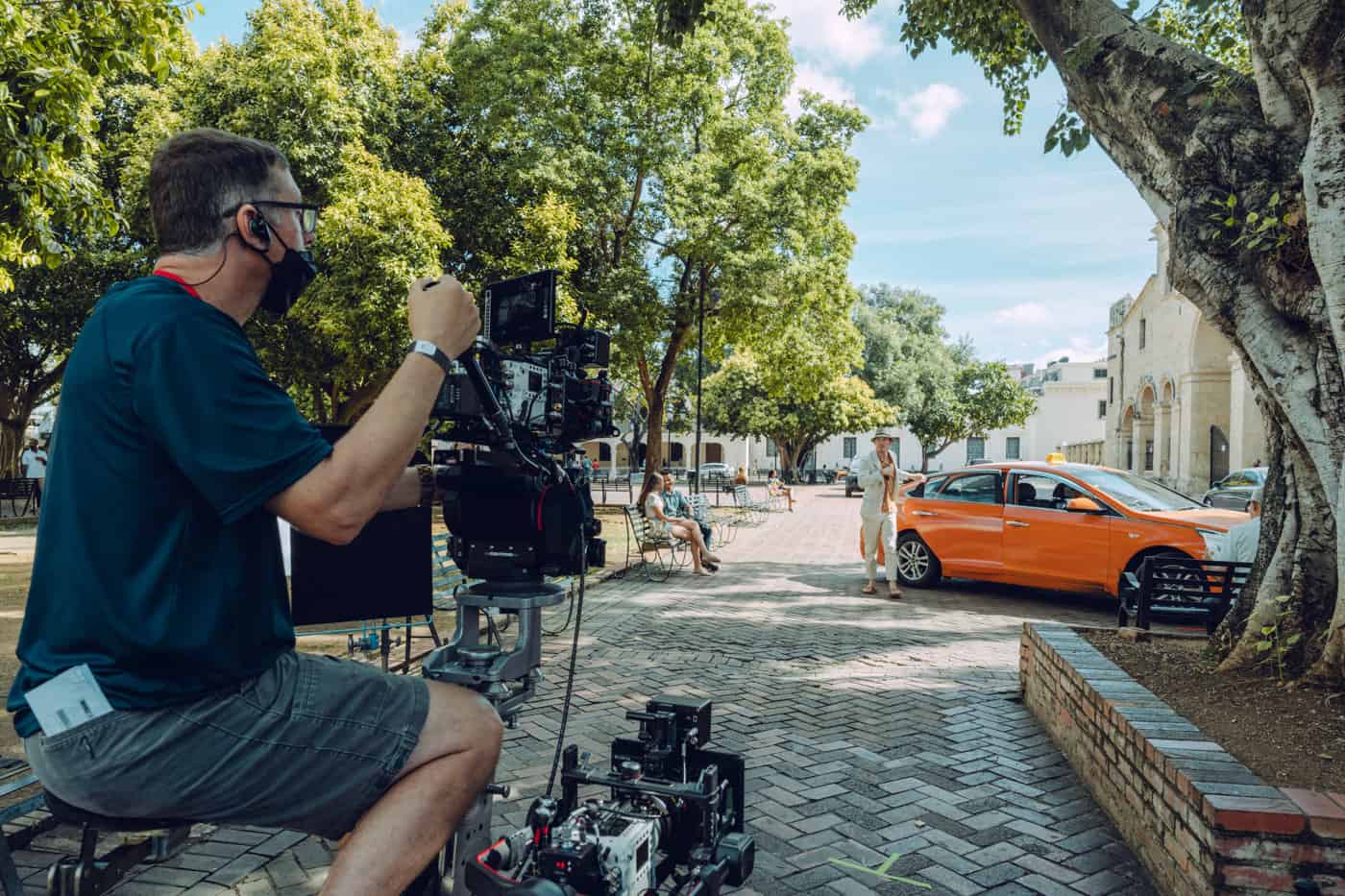
Camera operator Brian Osmond, SOC, shoots THE KILLER
CO: That’s really interesting! Like you said, the whole movie from that point is about him trying to reclaim that sense of control and it just constantly slipping through his fingers. It’s sort of subtle in its comedy, but at the same time it’s very funny. Just this constant push and pull between the image of himself that he wants to project in his own mind through this narration, and then what we see actually happen on the screen. On that level the filmmaking never quite tips its hand at the joke, but the comedy is in that juxtaposition between what we’re seeing and what we hear in his mind. What kind of conversations went into finding that balance of playing the visuals straight without robbing that element of comedy of its punch?
Osmond: There wasn’t much open discussion about that. It’s a subtle thing and was generally shot in a conventional manner. It’s maybe important to mention that the narration wasn’t there. We had little in the script in terms of what narration happens, and of course when you’re shooting there’s no narration happening at all. So, you don’t feel that juxtaposition in the moment, you’re just shooting. Additionally, a lot of narration was added after the fact that was not in the script. So, the comedic tone wasn’t especially obvious at the time. The plane tickets were funny. I think the very first one I didn’t notice—we’re just shooting an insert, I didn’t think about it—but with the second one, I thought, “wait a second. Archie Bunker?” Those were just fun to shoot.
But I think, ultimately, the comedy works because it’s shot so straight. The actual photography is like a straight-man setup, and it’s the juxtaposition with the narration that pays it off. A good example is when he kills the lawyer played by Charles Parnell. He shoots him in the chest with a nail gun, and eventually he’s on the ground. He’s fallen over, and he dies rapidly. There’s this moment of our character realizing, “Well, shit. I needed to get the names of those hitmen.” So, we shot that in straightforward manner. There was no apparent joke at the time, but in the narration—which I believe was not in the script for that particular scene—he’s talking about how many minutes he has to interrogate him before the blood fills his lungs, and then this guy only lasts 90 seconds. What the heck? And there’s this look from Michael, and it’s oddly funny. You realize after the fact it’s actually a strangely funny movie for being as violent and aggressive as it is.
CO: You talked a little bit about the destabilization and how that’s a new tool in the toolkit, so to speak. This is maybe more of a visual effects discussion, but just thinking about new techniques, I saw this really interesting visual effects breakdown for the film that was going around online. It’s right after the initial botched assassination, Michael Fassbender’s character is fleeing the scene on the motorcycle, and apparently that was an entirely digital character on a digital motorcycle, and you were just shooting the plates to put him in after the fact. Did you shoot any of that stuff, or was that separate team?
Osmond: I did not do the plate work. That was done in Paris with a good crew there. At the very end of the film, we were in Los Angeles, and we went to a stage for about a week and we did a bunch of driving work. Most of the scenes of him driving—with the cab driver, any time he’s in a car, basically—almost all of the driving stuff was shot on stage, and I think all of that’s seamless in the film. We also did shots of him for the motorcycle, and that was done with LED walls. Usually the LED wall was for lighting, so you get those fine, subtle details on the skin on the hair, or on the chrome or the plastic. I remember having a lens about four inches from his face, so I’m sure they used some of that, but it was manipulated. Again, face replacement and even creation of an actor and things like that, it’s a powerful tool. There’s definitely potential for it to be overused or misused, but there’s no arguing that it’s a tremendous tool, particularly when you have safety involved. We want a close-up of him driving the motorcycle pretty fast on these narrow streets, but it’s not practical to have him do it, and it’s definitely not practical to do it with a lens inches away from his face. So, you have to figure it out. We have these tools, so yeah, let’s do that because we don’t want him to crash the motorcycle.
We did shoot some of the driving practically, though. In the past, we’ve typically done process shots for all of the vehicle work, but this was the first time since I’ve been working with Fincher that we used car mounts. By the way, Michael Fassbender is a tremendous driver. His other hobby is racing cars. So, for all the driving stuff, oh my gosh, that guy can hit a mark in a car! There were times where I’m on track with a dolly and he’s pulling up in a car, that guy can hit a mark within an inch in a vehicle. I think he took some pride in being able to do that.
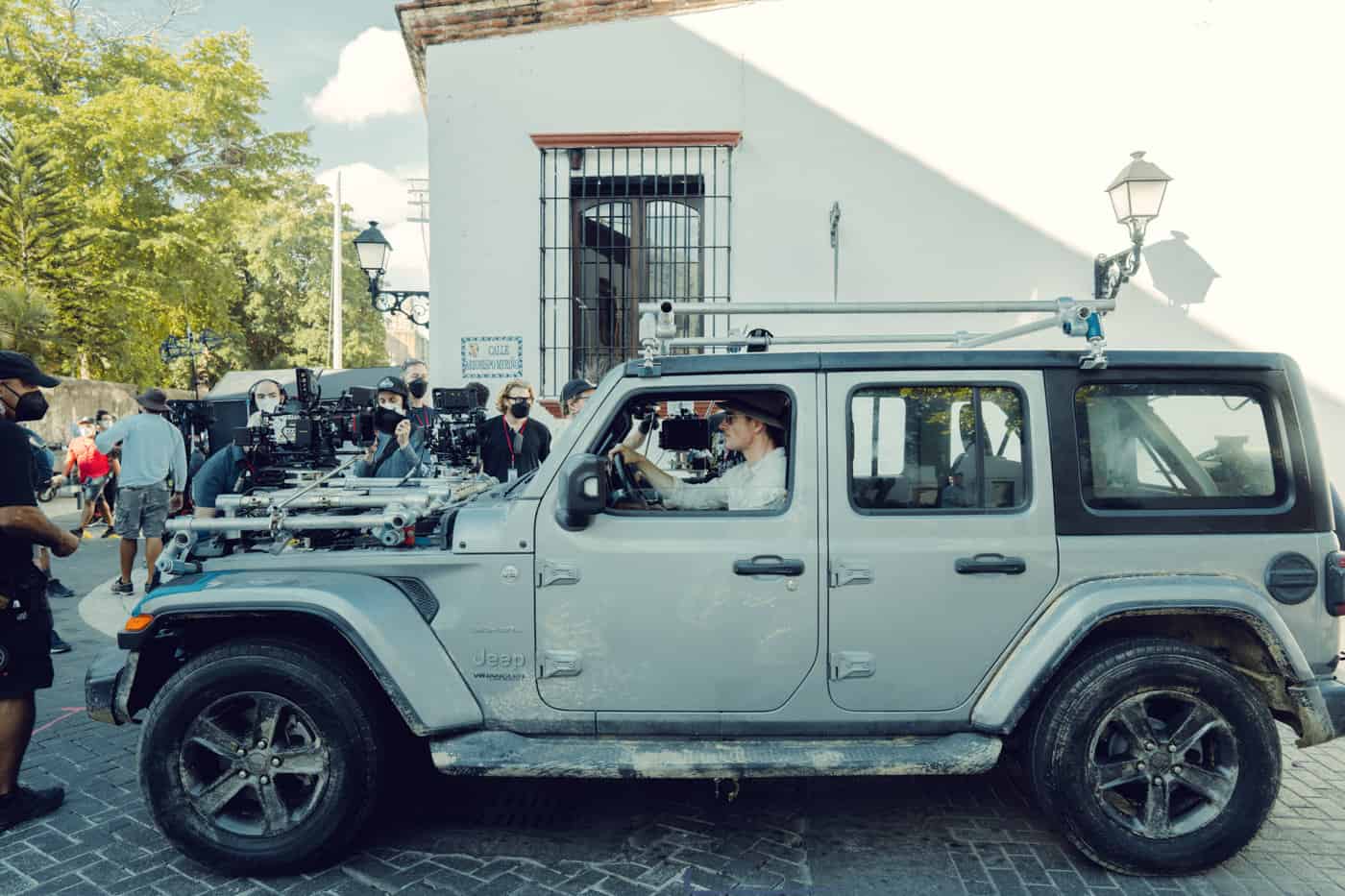
Preparing to shoot a scene of THE KILLER with with Michael Fassbender
CO: Going back to what you were saying about the movie being so heavy with narration, but none of that being there while you’re shooting. When you think about it, a lot of this movie is like a silent film. It’s just often Michael Fassbender by himself for long stretches without any dialogue. What was it like shooting in that way, perhaps harkening back a little bit to an older style of filmmaking?
Osmond: First of all, Michael is a tremendous actor and a wonderful guy to work with. I think he is just extraordinarily well cast for the film. He was on board from the first day with the challenge of what you’re talking about. It’s a lot of him, and a lot of him not talking. That can be a little intimidating for an actor. You know, you’re so used to dialogue—you read a script, and usually it’s dialogue, dialogue dialogue—but with this, you read it and it’s like, okay, no one has said anything now for 20 pages. It’s arguably a little out of the norm. Sometimes my assistant, Alex Scott, and I would talk about that challenge visually. It was at times unsettling because there’s this realization that the audience does not have dialogue to listen to. They can’t be told the story. Expository dialogue is an easy way to advance the story, but this had to be done more like a comic book. You have to tell the story visually and hope that his emotion, his thoughts are coming through on screen. It’s augmented by the narration, but it’s not told by the narration.
For this reason, I think we all felt responsibility to keep this interesting visually, there isn’t a bunch of talking heads. You have to keep this alive and keep the viewer interested visually with composition, with movement, with lighting. Michael is a great character to look at. He has amazing nuance in his performance—it is a real testament to his acting ability. I would be willing to bet that many actors would be unsettled by the fact that you’re gonna go 25 minutes and you’re not going to say a word. That’s a lot of pressure for an actor, where you have to tell all sorts of emotions and story with only the tiniest movements of your face. That is something I would think about, always telling the story visually. You can’t cheat it. There’s nobody talking, telling you what you’re supposed to think about the situation. And David is great. He’s very decisive about what works and what doesn’t. One thing David certainly always has is vision. He never lacks for that on a film. David is a prepared director and so we always have a clear plan.
CO: I know you’ve worked with him previously on Mank as well as Mindhunter, as you mentioned. What has that working relationship been like as it’s developed over these various projects?
Osmond: It’s a pleasure working with David. Now that I’ve done three projects with him, it’s familiar. It’s nice because you have a relationship, and out of a relationship comes things like a shorthand in working and understanding of style and aesthetic. You begin to naturally understand what they’re after without explanation. And also, out of that relationship comes a trust; I trust them, and they trust me to get it done. That shouldn’t be underrated. As a director, when you cut an operator loose to work handheld, there’s some percentage of them imparting themselves onto the scene. The camera becomes a little bit of a character in the scene. So, a director has to trust in the operator to allow them to go do that, and I have to trust that they believe in me, so that I can do my thing. Having a relationship that now is hundreds of days of shooting over the years at this point, it lends itself to better work. When you’ve worked with people for long periods of time—every day for many hundreds of days—it just greatly helps achieving an efficiency, a cohesive aesthetic and a better product.
It’s ultimately easier for me. After all the other work, doing something like The Killer, I can hopefully operate on a different level because there’s background there. There’s a relationship there. I can operate on a level that’s closer to what we’re trying to achieve.
We have a wonderful team. Erik [Messerschmidt] is a tremendous cinematographer. He’s really a wonderful guy to work with. David and Erik are very loyal, and they maintain a core team. First AC Alex Scott and dolly grip Dwayne Barr, those two guys are with me all day and really practice their craft at a high level. They are exceptional technicians. I say this, and perhaps it sounds trite, but I genuinely could not do the work that I do without them. I need us to be a team to achieve the work David wants. We have a core team on production, and there’s just a real pleasure and camaraderie and efficiency that develops from continuing with the same people. You can solve problems quickly. Even better, you can anticipate what needs to be done because we have a sense of what David is going to want. If we’re trying to work out something that’s going to happen a month from now, I have a sense of what David’s ultimately going to want to achieve so that I can inform the technical requirements, or even just the R&D that will ultimately achieve that because I know what he’s after. It’s from that continued work together that these positives evolve.
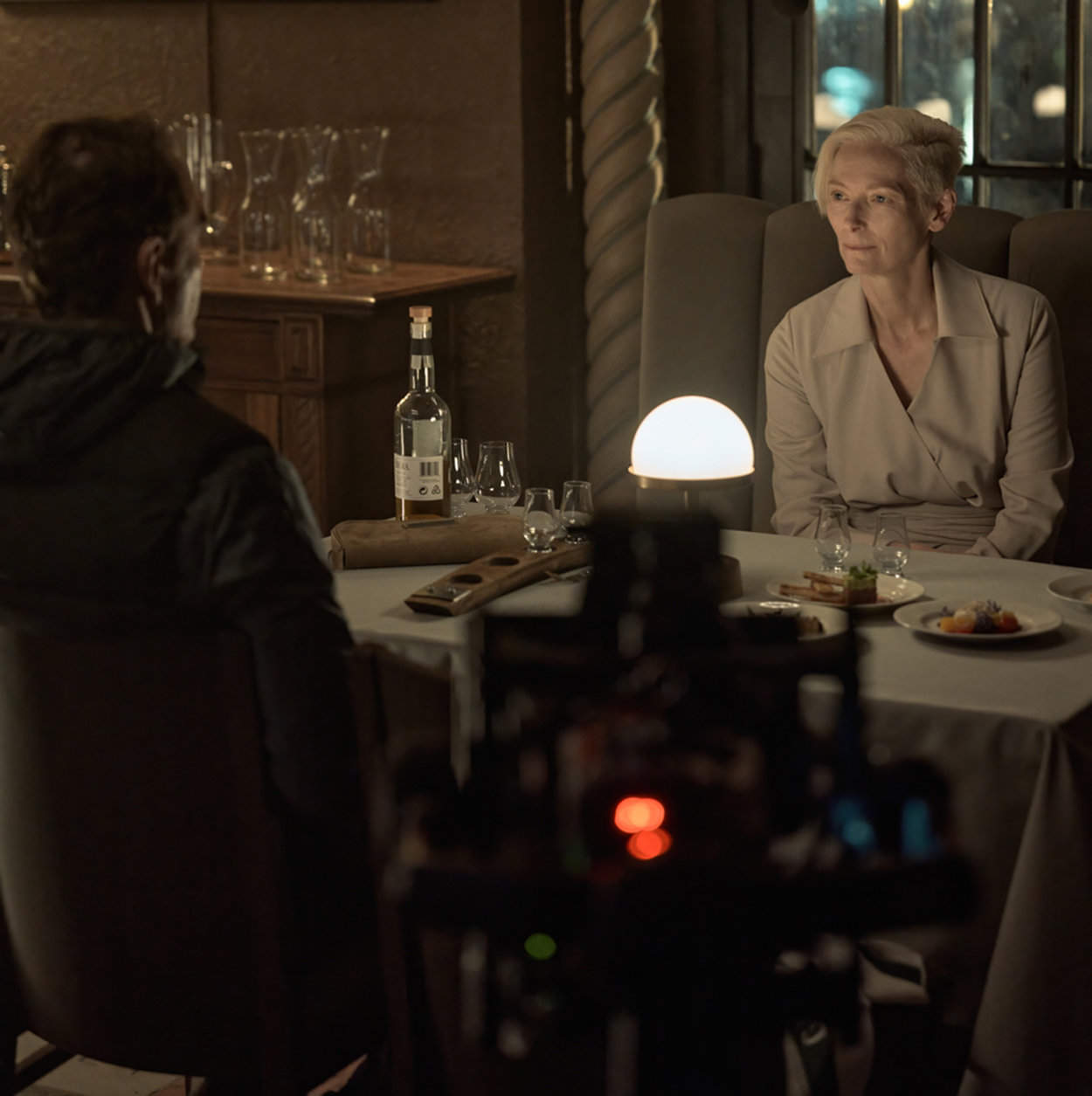
Camera operator Brian Osmond, SOC, shoots THE KILLER with Michael Fassbender and Tilda Swinton
CO: I wonder, do you have an example of something where you feel like having that sort of relationship with David, with the other members of the crew, really helped on a specific scene or specific shots?
Osmond: A couple things come to mind. One is the sequence when he arrives at his lair in the Caribbean, when he realizes that something has happened. That’s all handheld. He comes in the house and sees the aftermath of the fight, and that was mostly me, mostly handheld. Again, handheld is very free, so I’m allowed to do a bit more. In that case, it was like, “Here you are, we’re going to do this all handheld, and it’s you and it’s Michael. Go knock yourself out.”
Another is the scene with Tilda Swinton. The two of them talk in the restaurant for a while, which was shot very traditionally, but then when they’re outside, now, they’re gonna go for the walk. This was shot in St. Charles, Illinois, and it was bitter cold that night. That snow was real. It started snowing. And we’re like, “What are we going to do?” Well, the forecast is just going to be like this for a while so let’s shoot. Let’s just do it in real snow. They go for a little walk, and you know she’s going to her death. There was some conversation of how we were going to shoot it because the location was not terribly friendly for cameras. It was a real location, and there were these hedges and things, and the walk was very narrow. I was part of the conversation figuring out what would be the best way to do it, because initially it was designed to be big oner. But doing it handheld, doing it Steadicam, doing it with a dolly, doing it with a crane, they all had problems. Every single option had a challenge that caused it to be vetoed. Ultimately, we came up with solutions together, and it was not a big oner in the end. I think it’s better for it, to be honest.
Ultimately, it’s a collaboration, and I’m just happy to be invited to the party to help offer solutions and my thoughts. What do we want to do? What do we all think? And that’s fun! Solving those problems is rewarding.
CO: Oh, yeah, I imagine so. Like you said, it’s a collaborative art form, and you can plan as much as you want, but there will always be these unanticipated challenges and things that you have to think on your feet and overcome in the moment.
Osmond: Yeah. Those are a couple of examples that come to mind. And then you have the whole brute fight. That was an adventure. The brute fight was a monstrous amount of work. I think the result’s pretty strong, and boy, they worked hard.
We spent many days on that. It had been extensively choreographed, the stunt team had been working weeks, months even, figuring out how to do it. That was all a stage—basically they built a house on the stage, and it was all rigged. Everything was pre-planned. That was something where there’s very little ad-lib. Every beat was figured out, at least the physicality of it. And that was a combination of actual handheld and destabilized handheld. It depended on what we were doing. Erik has talked about this, that there is a logistical physicality to handheld that affects the shot. If you’re handheld, the camera’s on your shoulder, and you have the actor in front of you, roughly the same height. It’s all very natural. But if you want the camera to be handheld, but six inches off the ground, and it has to travel across the floor, well, that’s not so easy. That’s not so natural. Now you’re trying to come up with ways to do that. It can work and it can be great, but a lot of times we did that stuff on a dolly. Then you can get the camera exactly where you want it to be, the composition exactly what you want it to be, and then it’s destabilized to retain the handheld feel. You might have a big movement from the actors and want minimal movement from the camera so you can see what they’re doing, or you might want to reverse. So this is maybe not a new technology, but a new tool in the tool box, and I think it’s interesting to use.
But yeah, the brute fight was a lot of work. It was fun at times, sometimes it’s funny. There’s a little joke in there where right in the middle of this brutal, sadistic fight, he’s hiding behind the kitchen counter, and there’s kind of a break in the fight for a moment. He reaches up and grabs for something out of the drawer. He’s thinking, “I need a weapon. I’m gonna lose here.” And he pulls out, like, a lemon zester. Now that, I will say, was hilarious in the moment. And I seem to recall that there was a bit of serendipity in that. I recall that might have happened by accident. I could be wrong, but I think it was meant to be a knife, and he pulled the lemon zester instead, and it ended up being perfect. So, circling back to the comedy thing, there were times it was just straight-up funny, and I think that’s a great moment in the film because that sequence is so heavy, it’s so violent, and that lets the audience breathe.
Right at the beginning of the fight, they’re in the bedroom, and they’re grappling and he gets thrown into a TV. The TV was really powered on each time, just playing some piece of video, and we broke every TV they threw him into. I walked outside the stage at one point, and it was just boxes of the Sony TVs lined up like dominoes. They couldn’t take them out of the boxes fast enough. I think they broke, something like, 12 TVs in half an hour. It was kind of tragic, but also humorous. And, boy, the stunt team led by Dave Macomber, they really did a phenomenal job. They were extremely prepared and did great work on that fight sequence. One thing I love about it all is that it is not quite like a movie fight. So many movie fights are very choreographed, very flashy, but if you’ve ever been in a real fight or seen a real fight, they’re nothing like movie fights. Not, at all. The whole brute fight comes off as incredibly violent and very messy. That was something interesting to do visually, They’re just grabbing at anything they can to fight with. That’s what people really do. They’re just trying to do anything to deal out damage. It’s very long, ridiculously so. No one could sustain that level of punishment and walk away from it. And they take so much punishment. It’s more dark humor. A very violent fight, but at the same time, if you step back from it, there’s this strange comedy to it all.
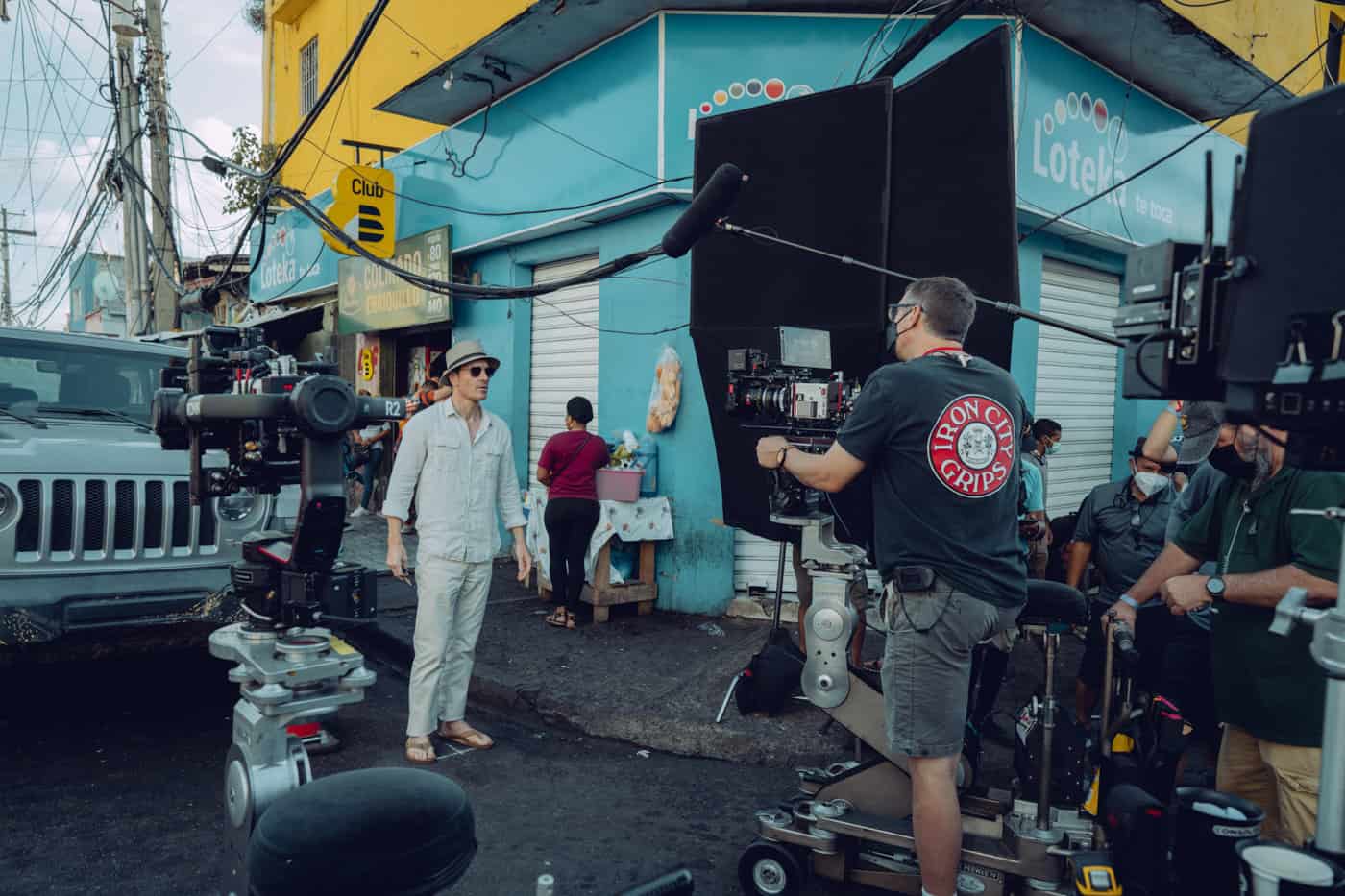
Camera operator Brian Osmond, SOC, shoots THE KILLER with Michael Fassbender
Camera Operator Winter 2024
Above Photo: Camera operator Brian Osmond, SOC, shoots a scene with Tilda Swinton and Michael Fassbender for THE KILLER. Photo by Miles Crist/Netflix
Additional photos by Monaris/Netflix
TECH ON SET
RED V-RAPTOR Camera
Leica Summilux-C Lenses
DJI Ronin Stabilization System
Technocrane with M7 Head
Arm Car
Grip Trix Camera Car
RELATED CONTENT
Watch the Trailer for The Killer
Brian Osmond, SOC
Learn more about Brian’s career and projects at IMDB.com
Camera Operator
BEHIND THE SCENES
Select Photo for Slideshow
Brian Osmond, SOC
Growing up in Pittsburgh, Pennsylvania, and studying computer science was not an obvious path into the film industry. But a couple of diversions led Brian Osmond into still photography and then to filmmaking. He abandoned computers and launched into the movie business at the bottom of the camera department as a camera trainee on Silence of the Lambs. Over the years, he spent time rising through the department, learning from the many wonderful mentors around him. Working with David Fincher on Mindhunter was a unique opportunity. The precision and elegance of his work was both challenging and rewarding, and changed how Brian now looks at using the camera to tell stories. He’s been fortunate to work with great people over the years on projects such as Mank, Devotion, and Ferrari and enjoys each day at the eyepiece.
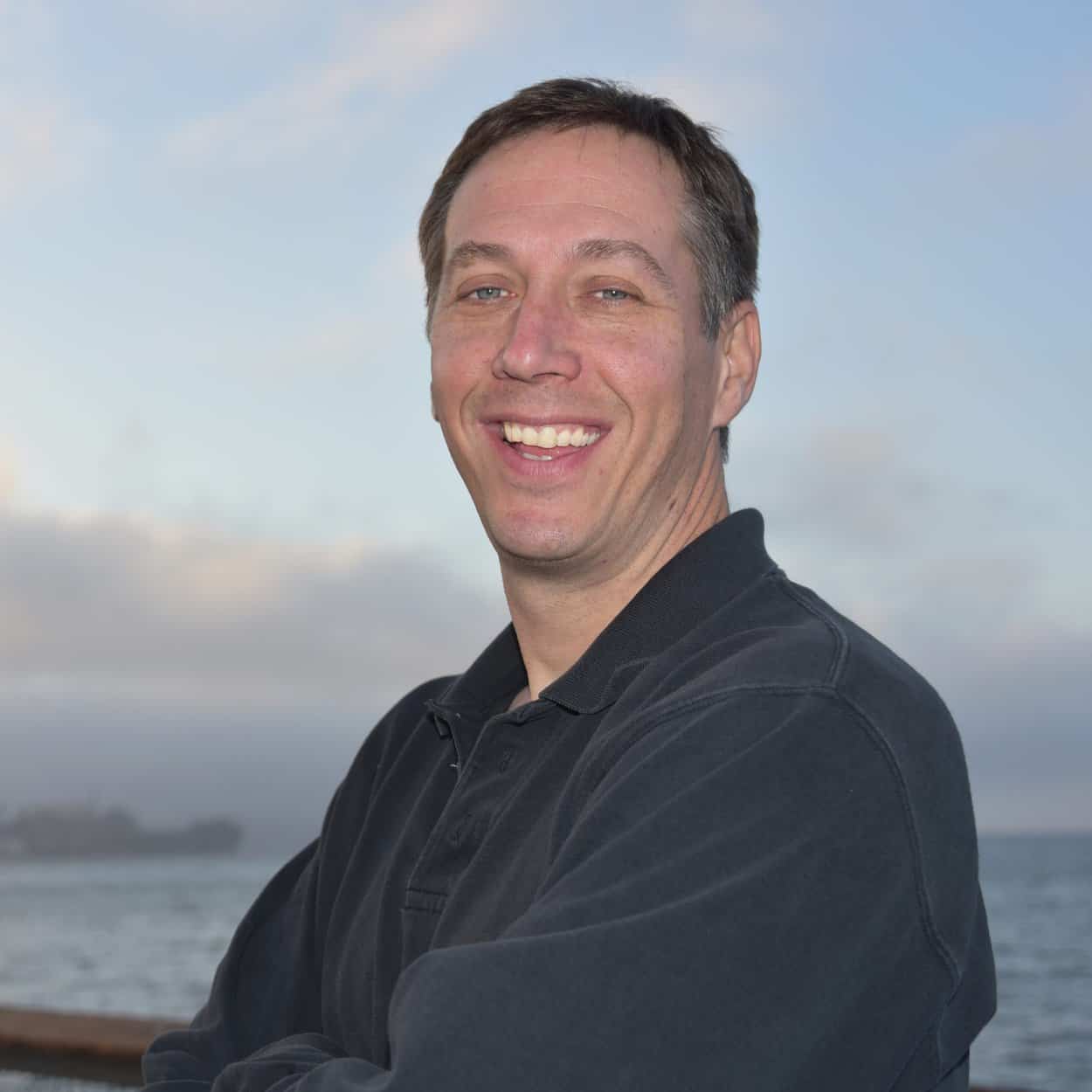
A writer and critic for more than a decade, David Daut specializes in analysis of genre cinema and immersive media. In addition to his work for Camera Operator and other publications, David is also the co-creator of Hollow Medium, a “recovered audio” ghost story podcast. David studied at the USC School of Cinematic Arts and works as a freelance writer based out of Long Beach, California.
